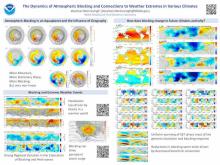Uniform Warming of Sea Surface Temperatures explain Blocking Reduction in Warming Simulations, but Pattern Changes are Important too
Veeshan
Narinesingh
NOAA GFDL
Poster
Atmospheric blocks are large-scale midlatitude circulation systems that can lead to devastating weather. In this work, coupled ocean and prescribed sea surface temperature (SST) simulations are utilized to study the drivers of wintertime atmospheric blocking and midlatitude circulation responses in warmer climates. First, we compare a historical simulation of the coupled model to an end of the 21st century, RCP 8.5 projection. Compared to the historical simulation, the RCP 8.5 simulation exhibits poleward shifted jets and amplified stationary wave patterns. A reduction in blocking is found over North America and the Pacific Ocean with some increase over parts of Europe. We then turn to the prescribed SST experiments. The RCP 8.5 SST changes are decomposed into a uniform warming component plus a spatially dependent change in SST pattern. Wintertime midlatitude circulation changes are found to be primarily driven by uniform SST warming. Uniform warming also accounts for most of the RCP 8.5 blocking decrease across North America and the Pacific, but not over Europe. El Niño like SST pattern changes also results in less blocking over the Pacific and North America, however, adding the responses of uniform and pattern simulations results in a non-linear overreduction of blocking compared to the RCP 8.5 experiment.

Poster file
Narinesingh_Veeshan_blocking_poster.pdf
(4.62 MB)
Meeting homepage
